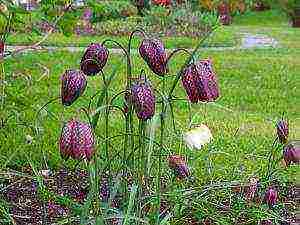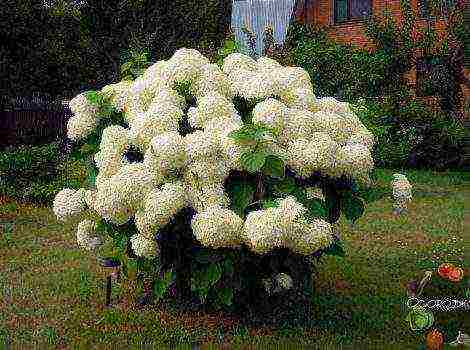Content [show]
The most favorite berry of children and adults, of course, is strawberry. The first berry vitamins after a long cold winter are contained in bright strawberry fruits... She is present on any garden plot and in the spring she is the first to receive the attention of the owner, who wants to get an early harvest. In this review, we will talk about the features of planting strawberry seedlings in open ground and further care.
Dates for planting strawberries in open ground in spring
Often gardeners ask themselves in what month is it better to plant strawberry seedlings? The optimal timing for spring planting of strawberries depends on the growing region and weather conditions (air temperature and soil warming). In the Moscow and Leningrad regions, in the Urals, this is around the end of April beginning of May... In the south, seedlings are planted earlier.
You can plant seedlings and at an earlier date, having previously covered the area for planting with agrofibre for the earliest possible warming up of the soil. Having planted the seedlings in the prepared soil, they create comfortable conditions for growth by covering them with spunbond or film on the established arcs. Step-by-step instructions for choosing seedlings and planting them in open ground are given below.
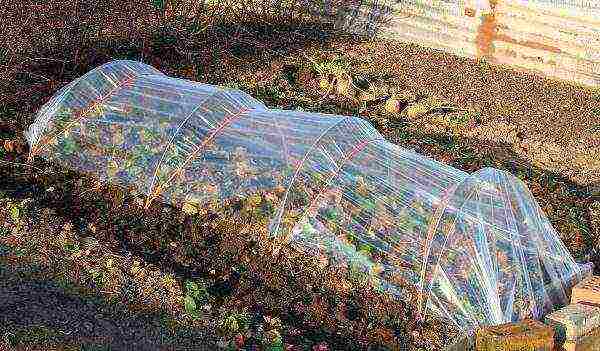 Planting strawberry seedlings under a film
Planting strawberry seedlings under a film
When planting in spring, the main thing is not to delay the planting dates and plant strawberry plants before the hot summer days.
Selection of seedlings for a good harvest
Correctly chosen seedlings are a guarantee of the future strawberry harvest, therefore, the choice of planting material must be taken seriously.
Strawberry seedlings can be purchased in several types:
- closed root - seedlings grown in pots, plastic cups or cassettes;
- with an open root system;
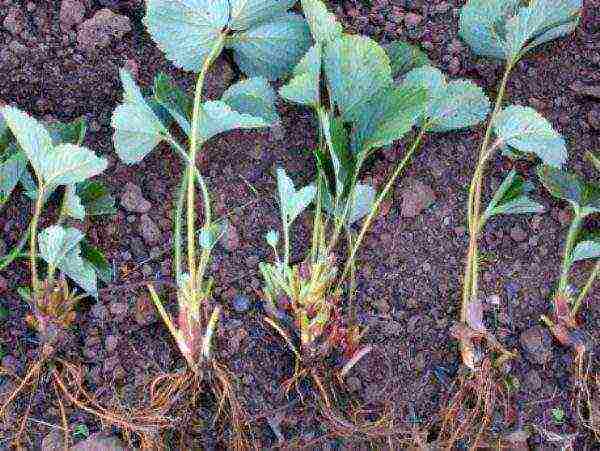 Strawberry seedlings with an open root system
Strawberry seedlings with an open root system
- green seedlings - plants dug up just before planting and not subject to long-term storage, it is best if they are with a clod of earth;
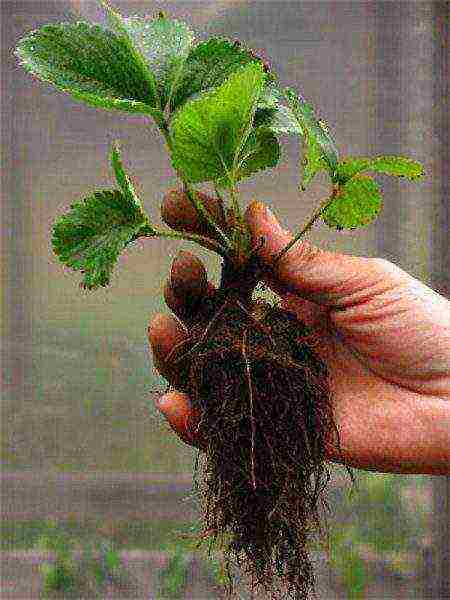 Green strawberry seedling
Green strawberry seedling
- frigo - these are annual plants dug up in the fall, with a root system cleared of the ground and a completely removed leaf apparatus, stored before planting at a temperature of -2 ÷ 0˚С (frozen seedlings).
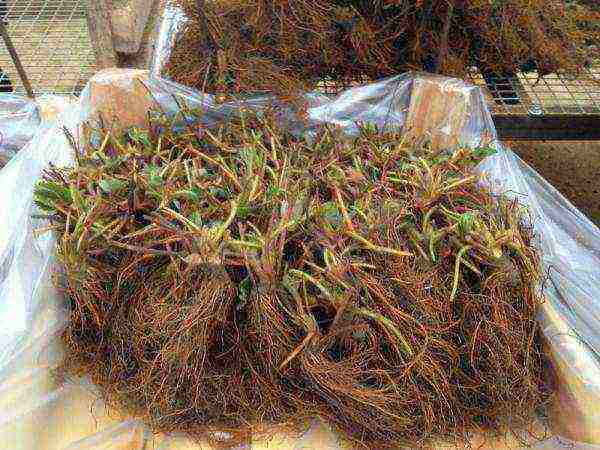 Frigo - frozen strawberry seedlings
Frigo - frozen strawberry seedlings
When choosing any seedlings, you need to pay attention to:
- root system - it must be well developed. When buying seedlings with a closed root system, well-developed roots germinate through the drainage holes, which indicates their good vitality;
- the seedlings should have at least 3-4 leaves saturated green color, without signs of wilting, brown spots and dots;
- "Heart" (the central bud of the seedling, in which the flower stalks of the future harvest are located) should be large at least 0.7 cm in diameter.
Gardeners usually propagate their favorite strawberry varieties with a mustache growing from the mother bush... To do this, take the first outlet from the variety you like, the rest are removed during the season. If this is necessary for herself, then she is simply given the opportunity to take root next to the bush, and in the spring she is transplanted. If for sale or to share with friends, it is rooted in a glass, placing it next to a bush.
Having chosen the correct planting dates and high-quality seedlings, the survival rate of seedlings during spring planting is up to 80%.
Preparing seedlings for planting in the garden
Seedlings with a closed root system, you can take your time to immediately plant in the ground, they can develop painlessly in containers for up to 2 weeks.
Seedlings with an open root system, if it is not possible to plant immediately, before disembarkation, they can be placed in a dark plastic bag, sprinkled with water and put in a dark cool place where they can stay for up to 5-7 days. During this time, the plants will release additional white roots and take root well.
Before planting seedlings, you need:
- on each seedling leave no more than 4 leaves, remove the rest to improve survival;
- cut roots, their length should be no more than 10 cm;
- before boarding it is advisable to soak the seedlings in a solution of a growth stimulator, if seedlings with a closed root system, then water with a solution.
Spring planting methods - diagram and step-by-step instructions
There are several ways to plant strawberries, from which each grower chooses the most suitable for him.
In the tunnels
For an earlier harvest of berries and an extension of the fruiting period of strawberries in the fall, planting plants in tunnels is used. Remontant varieties are most suitable for growing in them.
The installation of shelters for strawberry beds can be started almost immediately after the snow melts. Installed 1 m apart, the iron or plastic frames of the tunnels are covered with a film or covering material. With the onset of steadily warm days and at the beginning of flowering strawberries, the shelter must be raised for ventilation and pollination of plants with insects.
For covering material
Planting strawberries on black covering material has become very popular, as it has a large number of advantages:
- the weeds don't break through through agrofiber, they stop growing under it due to lack of light;
- the mustache does not take root on iti and they are easy to delete;
- berries are always cleansince there is no contact with the ground;
- the roots of plants develop normally under the covering material, because it is moisture and air permeable;
- due to reduced contact of plants with the ground, strawberries practically do not get sick and it is not inhabited by pests, which means that it is not treated with pesticides;
- in winter under such shelter plant roots are warm and comfortable.
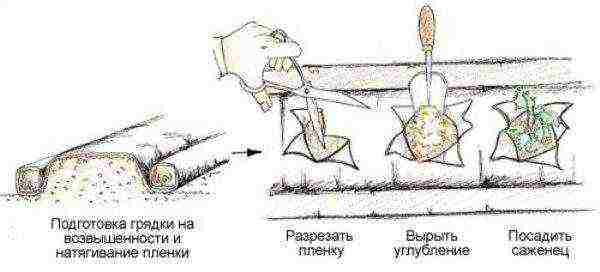 The process of planting strawberries on a covering material
The process of planting strawberries on a covering material
Nests
The essence of the method consists in planting plants in nests spaced from each other in a row every 30 cm, the distance between rows is 40 cm. Plants with this method of planting are planted in the form of a hexagon, with a distance of 10 cm between them., in the center of the figure is also a strawberry sapling.
 Planting strawberries in the nests
Planting strawberries in the nests
The advantage of the way is to obtain bountiful harvests, since there are 5 times more plants in the bush than with a normal planting.
Flaw consists in the need for a large number of seedlings, but when using your own planting material, it is not costly.
Bushes
The bush method of planting strawberries is planting seedlings in 40-60 cm.
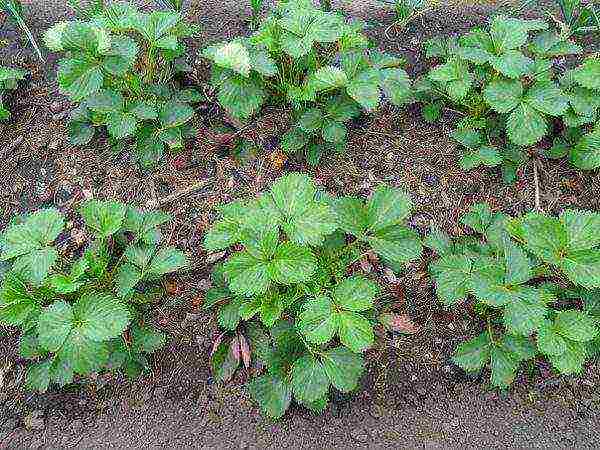 Bush method of planting strawberries
Bush method of planting strawberries
Berries with such a planting grow large, since the plants are not thickened, well ventilated, they are easy to collect, but the plantings must be constantly loosened and the growing whiskers must be removed.
In strings
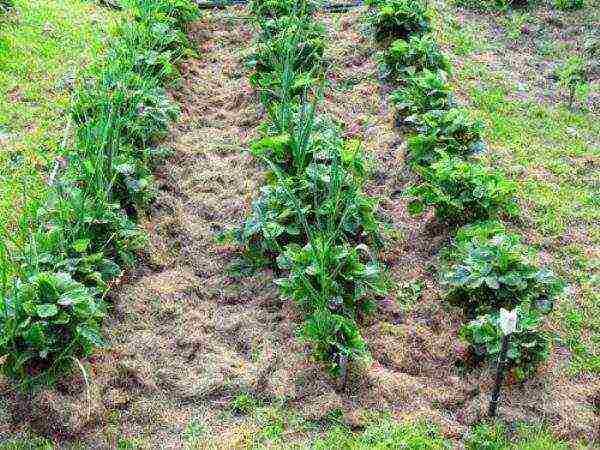 Planting strawberries in rows
Planting strawberries in rows
When planting plants in rows, one or two-line planting method is used, the scheme is shown below:
- With a one-line way the plants are planted every 15-20 cm, the distance between the rows is 70 cm.
- With the two-line method the distance between plants is not more than 20 cm, between rows 70.
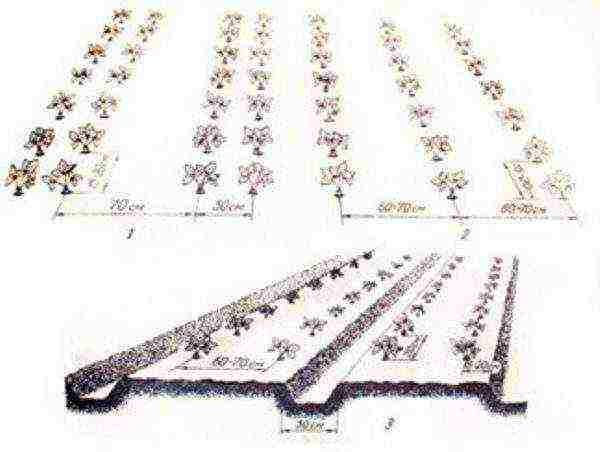 One and two line seating pattern
One and two line seating pattern
With this method of planting, it is convenient to rejuvenate the plants, directing the growing whiskers into the aisles, thus creating new beds, and removing the old rows.
There is still carpet method planting, the most common among summer residents, who rarely visit the plots or simply do not have time to care for strawberries.
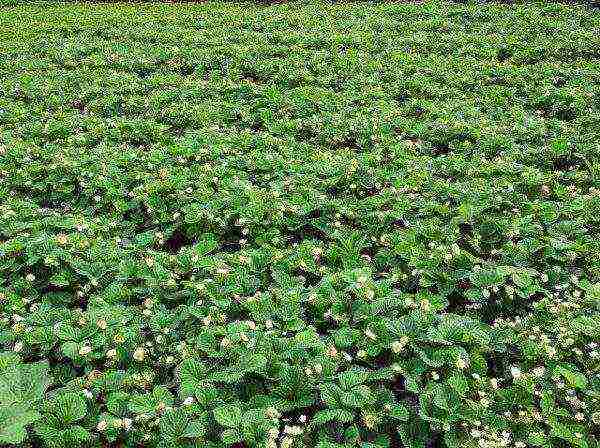 Carpet planting strawberries
Carpet planting strawberries
Plants after planting by any of the above methods are allowed to grow uncontrollably, i.e. the mustache is not removed and the planting turns into a beautiful solid strawberry carpet, under which weeds practically do not grow, moisture is retained. Landing does not need loosening, it is simply impossible to do it. The disadvantage of this method is the gradual grinding of the berries.
With any planting method, the root collar of the strawberry seedling should be at ground level.
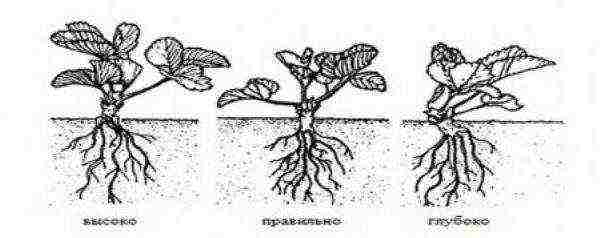 Scheme of the correct planting of strawberries
Scheme of the correct planting of strawberries
Proper care of seedlings after planting
After planting plants, for better survival, they need to be shaded by covering them with spandbond or dry grass.
Caring for newly planted plants consists of:
- In regular watering, since strawberries are hygrophilous. In dry and hot weather, plants need to be sprayed periodically.
- If the soil under the strawberries is not mulched, then weeding and loosening the soil required.
- At least three times per season (before flowering, during fruiting and after) strawberries need to be fed.
- Prevention and fight disease and pests.
- Removing extra mustacheweakening the plant. You can leave the first mustache extending from the mother bush, which can be used as planting material.
Every 3-4 years, strawberries need to be transplanted to a new place and plantations should be renewed with young plants in order to avoid the loss of varietal characteristics.
Using the following tips for choosing, planting and growing strawberry seedlings, you can perform a spring planting in a season Easily grow a good strawberry plantation, which will begin to bear fruit and enjoy its juicy and large fruits the next year.
One of the main conditions for obtaining large and tasty berries planted in spring is high-quality seedlings. The easiest way to get planting material is by rooting the mustache. If you decide to purchase seedlings from hand or in a store, you must be guided by special selection criteria. The first is the state of the root system. In good seedlings, the root processes reach 8 cm, moreover, the root collar should not be more than 6 mm, and the part that will be above the ground should have at least three leaves. The color of the root system should be white. If you notice that the seedlings have a weak root system or red stripes are visible on the processes, it is better to bypass such planting material.
The second criterion is the size of the so-called heart, or growth point. The harvest of the strawberry bush directly depends on it: the larger the heart, the more berries you will collect.
In order not to be deceived by the quality of the seedlings sold in pots when buying, you should make sure that the strawberries have not been placed in individual containers very recently. To do this, it is necessary to inspect the drainage hole of the glass. If the root tips stick out of it, then the strawberry bush was grown in it.
Preparing seedlings for planting at home begins with taking special care of the roots. In order for strawberries to take root in your garden better in spring, their root system is placed in a chatterbox made of orange clay.The composition of the talker is prepared as follows: clay is mixed with water and malofos and a growth stimulator are added. The chatterbox is stirred until a creamy state, and strawberry roots are dipped into it.

Preparing the soil for planting strawberries
In order for external factors to have a lesser effect on the cultivation of berries, select a section of soil in spring that is protected from the wind from the north. The beds should be arranged in a north-south direction. If you have purchased a large-fruited plant, you should take into account that the beds should be illuminated by the sun all day. Strawberries with small fruits can thrive in partial shade. You should not plant a plant in the spring in the lowlands, as cold air walks in them, and this is fraught with the development of various diseases.
It is also important to pay attention to what was growing on the site before the strawberries were planted. Onions, carrots, garlic, legumes, and beets are good precursors. If cabbage, nightshades or cucumbers previously grew in the open field in the selected area, it is not recommended to plant a plant. The ideal soil for planting strawberries is moderately moist and loose soil with a pH of 5-6. To enrich the soil by the spring, in the fall, annual green manures are grown on the selected site. Also, when digging the soil directly in the spring, compost or humus should be added to it in the ratio of two buckets per square meter. To improve the structure, about two glasses of ash are added to the soil.
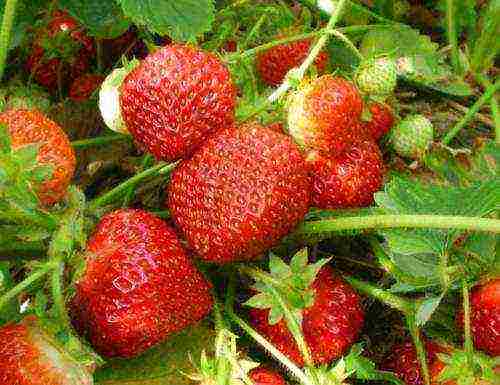
Depending on which strip of Russia the site is located in, the planting of strawberries in the spring occurs at different times. In the Middle Lane, the best period is mid-April - early May. On the territory of Siberia and the Urals, the berry is planted from the beginning of May to its middle. In the South, outdoor strawberry cultivation can be started as early as March. Growing methods also depend on the region. In the Middle Lane, seedlings are planted on beds with a height of 60 cm.This allows you to avoid wetting the bushes and achieve rapid heating of the soil, which has a positive effect on the yield. In a region with a milder climate, it is customary to plant bushes not on the very top of the ridge, but in the middle. This allows you to avoid rotting berries in the rain and at the same time overheating in the heat.
When planting strawberry bushes, you need to calculate their distance from each other so as to take into account that after a year or two, the plants and roots will change in size. The crowns of the bushes should not touch. It should be borne in mind that too small a distance between the bushes from each other will be the key to the appearance of small berries. Therefore, it is best if the distance between the two bushes is about 35 cm, and the row spacing is 60 cm. This, however, does not apply to small-fruited strawberries, which are most often planted with a solid carpet.
For planting in open ground, you need to form a suitable hole so that the roots that have already been straightened are placed entirely. Planting material is planted deep so that the heart of the strawberry remains above the ground. When the seedling is in the soil, it is sprinkled with a special mixture. It is prepared like this: a bucket of compost and rotted manure, two glasses of ash are mixed into a bucket of earth. For clay soil, sand is also mixed into the mixture. When the strawberries are planted in the spring, they should be watered and the soil mulched with straw.
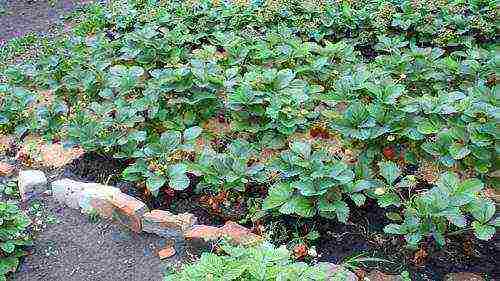
Growing in tunnels
If you want to speed up the ripening of berries in the spring, growing strawberries in the open field can be done in film tunnels. Early ripening varieties of plants are perfect for this process, while late berries, even when grown in the spring in tunnels, will not yield a harvest earlier than the due date.
To grow strawberries in a tunnel way, at the very end of April, wire arcs are placed over the bushes of the first year of planting, on which a film is applied. One of its sides should be well fixed, and the other should be left free for ventilation.Growing strawberries under plastic does not require special care for the seedlings. It is enough to ventilate the plants when the temperature goes over +25 degrees, water about once a week, and when the temperature drops, close the film again. When spring weather returns to normal, the tunnel can be removed and cultivation can be continued outdoors without film protection.
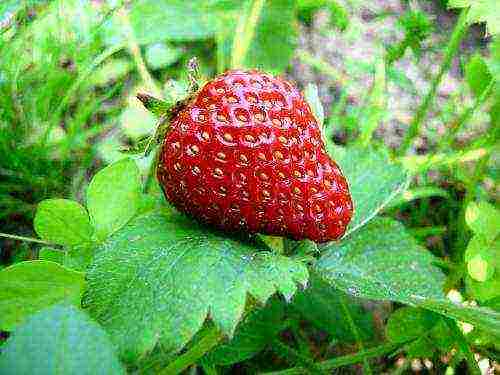
Growing on fiber
For another method of planting in the spring, black spunbond is used. The material is laid in strips after applying organic fertilizers to the soil and digging. Its edges must be secured with wire pins. Spunbond is laid with an overlap, the size of which should reach 20 cm. For convenience, a tile is applied to it to form a path for caring for strawberries. Further, on the spunbond, the places where the seedlings will be placed are marked. The fiber is cut crosswise and the edges are folded outward. A plant bush should be placed in the resulting hole and only then bend the corners of the material inward. In this case, the heart should also be above the ground. Strawberries planted on spandbond should be watered about twice a week, especially in hot weather. During the growing process on black material, the berries are fertilized with liquid mixtures.
Among the main advantages of growing a plant on a spunbond is ease of care - strawberries are not annoyed by weeds, and its antennae do not take root. Also, with this method of planting in open ground, the berry is less likely to suffer from slugs and ants. A big plus is that the harvest rarely gets sick for the reason that the berries do not come into contact with the ground.
However, despite the considerable number of advantages, this method of planting has a number of disadvantages. In hot, arid climates, the ground under the black material heats up to very high temperatures, which is extremely dangerous for the plant's root system. Also, spandbond cultivation is not suitable if the soil is heavy. The ground under the material cannot be loosened, and in its hardened state, strawberries will feel extremely uncomfortable.
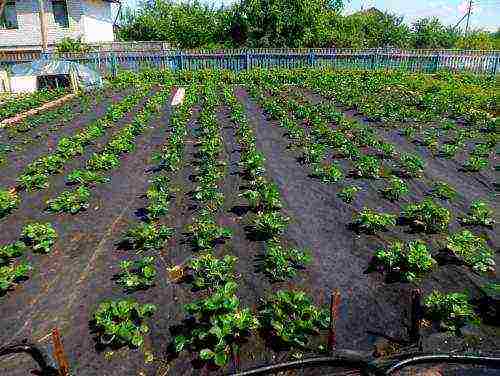
Strawberry care
Despite the fact that caring for this crop is considered very troublesome, you can get a good harvest by applying the above agricultural techniques. But in order for the bushes of the plant to bear fruit well next year, it is important not only to water and fertilize the strawberries on time, but also to cut off the buds and whiskers during the growing season. In autumn, a garden bed with bushes should be insulated with dry leaves. In order for the strawberries to successfully overwinter, there must be a lot of snow at the top of the garden bed during the cold season. To do this, put pepper or tomato tops on them, on which more snow lingers. When the next spring comes, dried leaves are removed from the bushes, and the bed is fertilized with granular preparations, after which it is loosened. Also, in the spring, the bushes need to be treated with substances that prevent the development of diseases and the appearance of pests. When the first buds begin to appear, a mulch layer of sawdust or straw should be poured under them. This is done in order to retain moisture in the soil, and, on the contrary, to protect ripening berries from wet conditions.

Early ripening strawberry varieties
Growing strawberries outdoors in spring works especially well if you choose a suitable early maturing variety. Among the best were "Alba", "Olvia" and "Octava".
The Alba variety tolerates frost well in spring, which means it is ideal for planting in Central Russia and Siberia. The plant shows resistance to powdery mildew, but is vulnerable to anthractosis. From one bush of "Alba" you can easily remove about 1.5 kg. Each berry removed can weigh up to 30 g.
Olvia is a strawberry variety that will allow you to feast on its berries already at the end of May. Gardeners often pick a kilogram of berries from one bush.This early maturing variety has a powerful root system, so it tolerates winter well. It is a drought tolerant plant.
"Octava" is famous for its very large berries, reaching a weight of 40 g. This variety is demanding for watering and fertilization, however, it is resistant to major diseases and pests.
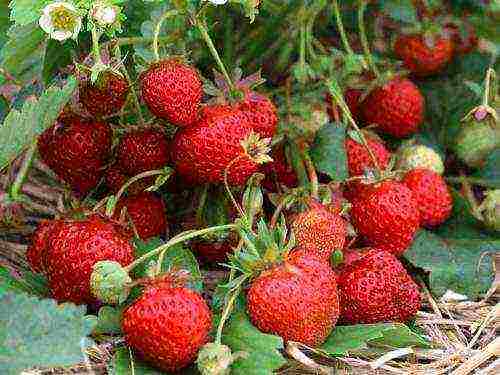
Large, juicy and sweet strawberries grown on their own plot with care and love are a source of special pride for the gardener. Fragrant strawberries are a real storehouse of vitamins and nutrients, available throughout the year, first in the form of long-awaited berries, and then in the composition of delicious compotes and jams.
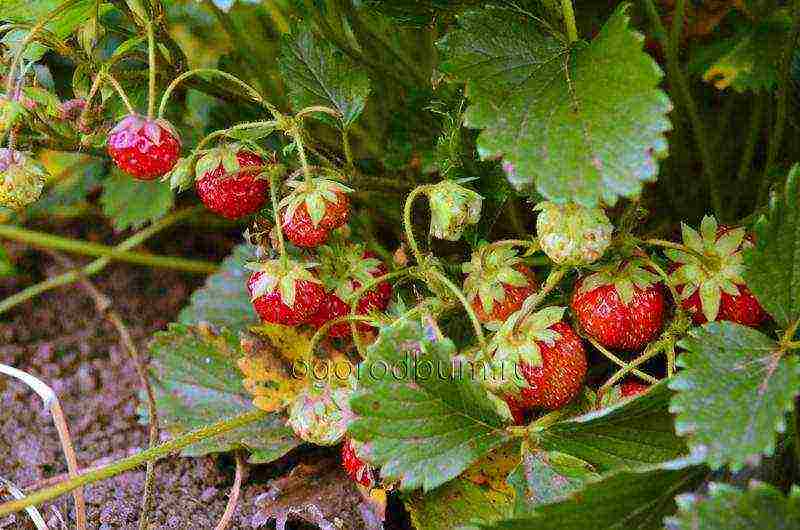
Planting strawberries correctly in spring will provide you with an excellent harvest for years to come. The timing of planting strawberries depends on weather conditions, but, as a rule, the berry crop is planted in early spring. Let's see what nuances of planting and care need to be taken into account in order to grow a truly tasty and large berry.
Choosing a site for planting
Choosing a place for a future strawberry plantation is a stage that many novice agronomists underestimate. Poor location is often the reason for poor yields and watery unsweetened berries.

How to choose a place for a good harvest in the future:
- For the garden, sunny areas located from north to south are ideal, the surface can be flat or have a slight slope.
- The bed should be located in a place sheltered from the wind, where in winter your plantings will be reliably covered with snow.
- Strawberries are quite unpretentious and undemanding to the soil, however, the best option for planting strawberries is black soil with the addition of ash. But on sandy or clay soil, the berry, most likely, will not grow. Humus can be added to improve soil quality.
- When choosing a place for a future strawberry ridge, you need to take into account the level of groundwater. The soil should not be dry and waterlogged.
- An important factor is the acidity of the soil, its indicator should not exceed 5.5-7.5 pH. In case of excess, the problem can be solved with the help of organic fertilizers, if the acidity is lowered, we fertilize the soil with a solution of limestone.
- It is important to take into account the type of the predecessor crop in the places of future planting - strawberries bear fruit remarkably in areas where cereals (oats, rye), representatives of legumes, carrots, pumpkins, onions and garlic previously grew. It is not recommended to plant strawberries in places where nightshades used to grow, such a soil is saturated with fungi that can destroy the strawberry family. Also, the old strawberry plot is not suitable for planting - in order to prevent the incidence of viruses in berries and to give the soil a rest, you should change the places where strawberries are grown every 2-3 years.
- It is not recommended to plant strawberries in an area adjacent to a field or forest area, in this case there is a risk of the May beetle appearing.
- You can not plant a berry in the lowlands, due to the accumulation of cold air, the harvest will be slow and painful.

Soil preparation
Planting strawberries in spring requires thorough soil preparation from the end of summer. First, you need to completely clear the selected area of weeds. Pay special attention to the destruction of sow thistle and wheatgrass - these plants take all the nutrients from the soil. You can well dig up the planting area and remove the weeds and their roots by hand or use herbicides.
An excellent effect, which greatly simplifies the care of strawberries, is provided by geotextiles - in the fall, the future plot for a strawberry plantation is closed with agrofibre.
A material that perfectly permits water, but not sunlight, kills weeds, and by spring it remains only to level the soil with a rake and remove large roots. Next, add compost to the soil and spread the agrofibre again. The strawberries are planted in the holes made. This method is very convenient and allows you to forget about weeding forever.Before planting, it is necessary to check the soil for the presence of pest beetle larvae. If found, the soil can be treated with ammonia water or an alkaloid lupine can be planted on the site. Having solved the issue of weeds and pests, we fertilize and loosen our soil. Then we mark the rows for the future strawberries.

Planting strawberries in open ground
Experienced gardeners identify several effective and time-proven methods of planting strawberries in the ground:
- Freestanding bushes. Strawberry rosettes must be planted one at a time at a distance of 65-70 centimeters. With this method, the tendrils of the berry are regularly cut off, thereby achieving high fertility from the bush. A rather laborious way to plant strawberries, requiring constant attention and care: frequent loosening and persistent weed control.
- Planting strawberries in rows. Single-row and double-row options are distinguished. In the first case, the gap between the ribbons is about sixty centimeters, and the distance between individual bushes is 15-20 cm. This planting method is used in early spring or autumn. Two-row planting can be carried out in the summer, which allows you to get a harvest already in the first year of planting. The gaps between the lines are 30 centimeters, between the ribbons - no more than 70. Strawberry bushes are planted at a distance of 15-20 centimeters from each other.
- Carpet landing. With this option, the strawberry antennae are not removed, allowing the berry to grow freely around the entire perimeter of the site. With this planting, it is easier to care for the crop - less often watering is required, and natural mulching inhibits the growth of weeds.

Seedling selection
In order to get an excellent harvest in summer from sweet and externally attractive berries, it is necessary to plant elite varieties of strawberries. High-quality seedlings should have a lush, fibrous root system with shoots of about eight centimeters. The bush should have at least 3-5 leaves with a healthy and large heart, at least five millimeters in diameter. The leaves should be smooth, deep green without pigmentation. Shriveled and curled leaves can indicate a culture lesion with pale necrosis or tick-borne diseases.
How to prepare seedlings
A few days before planting the berries, the seedlings should be placed in a cool place. Immediately before planting, the roots of the seedlings are dipped in a clay mash or placed in a weak saline solution for 20 minutes. The roots must be carefully examined again, carefully straightened and, if necessary, shortened to 8-10 centimeters.
Berry planting technology
Strawberries are planted on a cloudy day or in the evening, when the heat has subsided. The best option is to plant bushes after rain. In any case, the soil must be well moistened before planting. Seedlings should be planted in shallow holes so that the bush remains upright. The root collar should be at ground level. Having closed the hole with soil, it is necessary to slightly compact the earth, once again shed the seedling abundantly and mulch the planting site with sawdust, humus or needles.
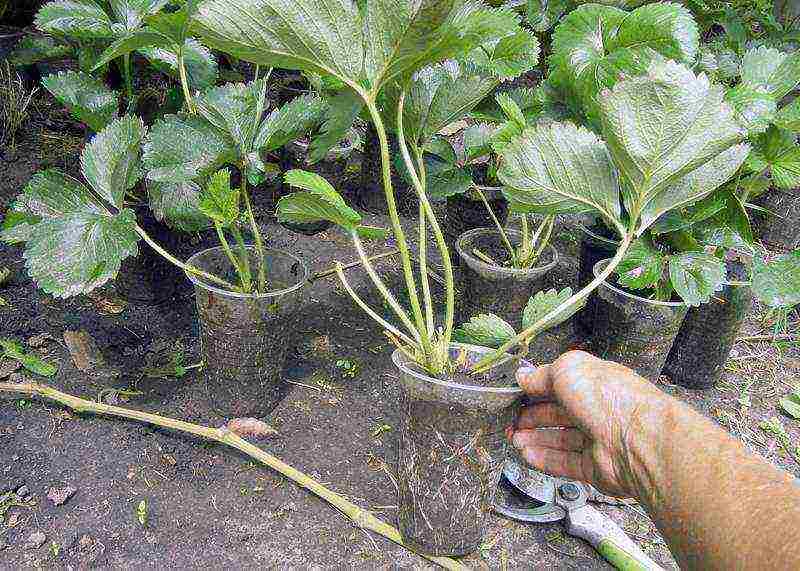
Proper care of strawberries
A good fruitful harvest directly depends on what kind of care the crop receives during development. Having planted strawberry seedlings in early spring, the rest of the time must be devoted to caring for the high-quality rooting of seedlings, and later competent preparation for the winter period.
Planting care includes regular watering of seedlings, loosening the soil, removing tendrils, as well as preventing diseases and pests. The first weeks after planting, it is necessary to water the berry daily and maintain a moist state of the soil; later, it is necessary to reduce the frequency of watering to once every two days. It is best to water in the early morning. It is important to remember that the berry does not tolerate both drought and abundant moisture.An excess of moisture can lead to diseases and berry rotting.
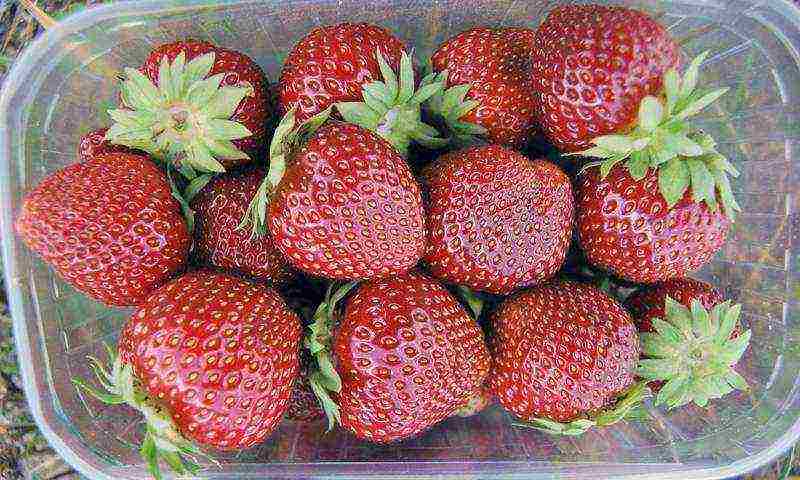
Winter care involves a reliable shelter of strawberries from frost. The snow cover must be at least 10 centimeters thick. Weeds interfere with the development of berry crops, taking away nutrients and moisture, so manual weeding should be carried out throughout the summer cottage. If there is a threat of pests, it is necessary to treat the bushes with special preparations. Processing is carried out either before the flowers appear, or after the harvest.
Planting and proper care of strawberries is a task that even an inexperienced gardener can do. Subject to simple requirements, your future harvest will delight you with delicious strawberries for several more years in a row.
Similar articles
The spring planting of strawberries will not bring a large harvest in the first year, but it has one important advantage: young bushes have time for better rooting, and in the event of the death of one or more seedlings, it is possible to replace them - after all, it is almost a year before the new season. In the article, we will consider planting strawberries in spring on agrofibre, as well as the technology of planting in open ground.
Selection of planting material
For transplantation to a new site, the first whiskers are selected from the most productive bushes. During harvesting, marks are placed near these bushes in order to take planting material only from them. This technique is called clone selection.
How to procure planting material?
At first glance, strawberries of the same variety have all the same bushes, however, upon close observation, it is noticeable that some bear fruit for a long time and give a small amount of whiskers. Others, having quickly matured, throw out the mustache first, and there are a lot of these mustache. If the material for planting is taken indiscriminately, then plants obtained from whiskers from unproductive bushes begin to prevail on the site.
When clonal planting is carried out for a long period, the quality characteristics of the variety are significantly improved, and its yield increases.
For transplantation, seedlings are selected with a root collar thickness of more than 6 mm, roots of at least 7 cm, well-developed and straight. The bush should have 3-5 leaves (weak and sluggish are removed), a well-developed bud. If the roots are longer than 10 cm, then they are cut off.
The prepared planting material is planted on the ridge as soon as possible. If the planting is delayed, the seedlings are buried in a shaded place or placed in a cellar with roots wrapped in moist moss.
Preparing the soil for planting
Strawberries love loamy, sandy loam, chernozem soils. Dark gray forest soil will also work. Strawberry plots yield the best yields when located on the southwestern slopes. Lowlands, where moisture and poor lighting can accumulate, are considered unsuitable for planting.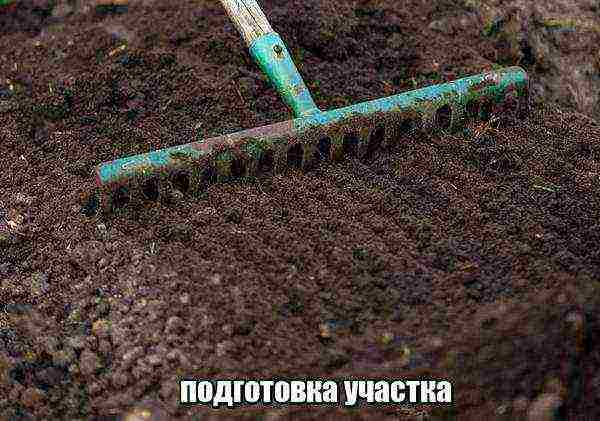
The acidity of the soil should not exceed 5.5-6.5 pH, and the groundwater should be located at a depth of at least 60 cm. Preparatory work is carried out in the following order:
- In the fall, the site is dug up, cleared of weeds, rhizomes and dead plants;
- Organic and mineral fertilizers are introduced (per 1 sq. M): manure - 5 kg, potassium chloride - 15 g, superphosphate - 50 g;
- During spring digging, hexachlorane dust is introduced - 15 g, ammonium sulfate - 20 g;
- Areas with predecessors are selected: onions, corn, peas, beets, carrots, pumpkin, garlic. Poor predecessors are potatoes, cabbage, radish, tomatoes, eggplants (after which, strawberries are easily affected by pests and diseases). If, before planting, sow green manures (marigolds, cereals, buckwheat, mustard leaves) on the site, then the composition of the soil will significantly improve and be cleaned;
- To remove perennial weeds, the site is treated with herbicides (Tornado, Roundup, Hurricane) 2 weeks before planting.A more environmentally friendly way is to cover the area with a dark film with slots for bushes;
- Before planting, the plot is rolled in with a roller - this makes it easier to plant the seedlings to the required depth, which is very important in the case of strawberries.
Strawberry planting technology in spring
Planting strawberries in spring should take place as early as possible to allow the plants to take root in moist spring soil. Strawberries are not afraid of cold weather, so when the soil thaws, you can start planting in early April. To speed up the heating of the site, vegetable growers cover it with a film.
To prevent damage by pests, the roots of the seedlings are soaked for an hour in a solution of garlic infusion (50 ml per 3 liters of water). Landing is done in the following order:
- Holes are being prepared, deep and wide. A bucket of soil removed from the holes is mixed with 1 bucket of manure and 1 bucket of compost, with the addition of 2 glasses of wood ash. A small mound is poured from the prepared mixture at the bottom of each hole;
- The prepared bush is set on a mound, and the roots are straightened to the sides;
- Then the roots are covered with earth with simultaneous watering (for better contact with the soil);
- The roots should be in a straightened and elongated state, not bend and curl, which can lead to their decay;
- The junction of the roots with the socket should be at the level of the soil surface - not lower and not higher. The growth point, or "heart", should be above the surface, and all roots - underground. This is the main point in planting strawberries.
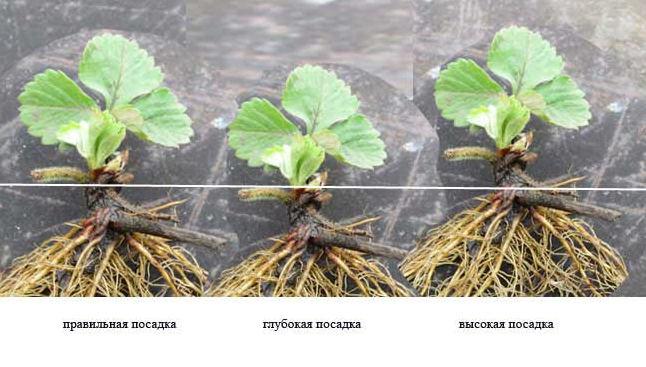
Features of caring for new landings
Young strawberry beds require particularly careful maintenance and increased attention. If the weather has not yet settled, and frosts are expected, the plantings are covered with film or spunbond, especially at night.
The appeared peduncles and mustaches in the first year after transplantation are subject to immediate removal - the plant will need all the strength to take root in a new place.
Watering is done as it dries - strawberries are very capricious in this regard. Lack of moisture negatively affects the development of plants, and excess leads to the appearance of diseases.
Mulching is a mandatory procedure - pine needles are best suited because of their bactericidal properties. Straw, rotted sawdust, dry grass and foliage are used as a substitute.
Two weeks after planting, fertilizing is carried out with vermicompost or organic infusion (herbal infusions, bird droppings). The easily assimilable nitrogen contained in them in large quantities contributes to the intensive growth of young seedlings.
Methods for planting strawberries in open ground
Planting young bushes can be arranged in several proven ways:
| Name | Description | Flaws | Dignity |
| Freestanding bushes | Distance between seedlings 45-60 cm | Labor intensive (frequent loosening, mulching) | Large berries, reduced incidence |
| Landing in the ranks | Row spacing - 40 cm, between bushes - 15-20 cm | Labour intensive | Good fruiting 5-6 years |
| Planting nests | Nest - 1 plant in the center, 6 around it, after 6-8 cm. Between nests - 25-30 cm, between rows - 35-40 cm | A large amount of planting material | Planting 5 times more plants for high yields |
| Carpet landing | The mustache is not removed, over time the ridge is completely covered with bushes | Over time, the berries become smaller | Minimal care (self-mulching and weed protection occurs) |
Landing in rows is carried out in two main ways: one-line and two-line.
With a one-line method, the distance between bushes is 15-20 cm with a row spacing of 70 cm, with a two-line method, plants are placed on ribbons, where the distance between rows is 30 cm, and between the ribbons - 60-70 cm. Two-line placement allows you to save space and provide higher yields for by increasing landings.
How to plant strawberries in spring on agrofibre?
Modern technologies allow the development of new planting methods that allow you to get high yields with minimal labor and time. One of these methods, which is rapidly gaining popularity, is the method of planting strawberries on agrofibre:
- The preferred choice of material with a density of 60-70 g / sq. m, which retains performance for 3-4 years. Dark-colored agrofibre retains moisture better, which is an additional plus for planting strawberries in arid regions;
- The width of the web is selected depending on the expected width of the landings. It is recommended to place tracks at the joints, and landings should not be done;
- Agrofibre is laid out on the prepared area and fixed with metal clips (at least 25 cm in length) or pieces of tiles. If it is necessary to make a joint on the ridge, then the overlap of the edges should be 20 cm;
- To increase the service life of agrofibre, paths are necessarily created from a special coating, sawdust or straw (walking on the surface of agrofibre is not recommended)... Sawdust is good because, when wet, it creates additional weight that presses the coating;
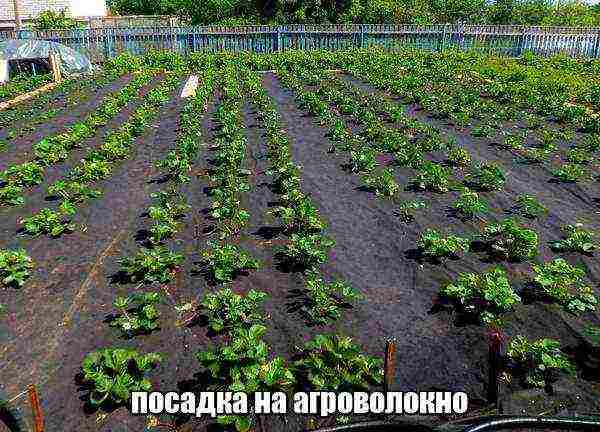
Planting strawberries in spring on agrofibre
- On the prepared site, the rows are marked with a cord. Landings are placed using a two-line method with a row spacing of 65 cm, between rows - 45 cm, between bushes - 25 cm;
- In agrofibre, cross-shaped cuts of 5 by 5 cm are made, the ends are turned outward;
- Long roots are trimmed (no more than 9 cm), the plant is placed in a prepared and spilled hole in the hole in the cover. At the same time, two main points are observed when planting strawberries: the correct placement of the growth point and the straightening of the roots;
- The cut edges are wrapped in the direction of the plant, and a drip hose is placed on the ridge near each row.
Agrofibre helps to retain moisture (by about 25-30%), so watering is carried out once every 5 days during a hot period. The advantage of this method, in addition to significant reductions in labor costs, is to obtain a clean berry.
Growing strawberries on film
After agrofibre, someone won't even want to look at film. However, growing strawberries on black foil is suitable for areas with a humid climate and severe frosts in winter. The film does not allow the soil to become waterlogged, and in the winter months it provides strawberry bushes with additional shelter from the cold. It is also important that the harvest in any case will be clean and protected from rot.
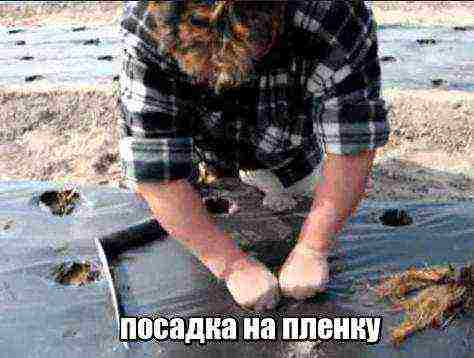
If you decide to use black film for planting strawberries, use the method of experienced gardeners: cut the hole not crosswise, but round it with small scissors. This will prevent the edges of the cut from expanding in the wind or inadvertently touching.
Processing strawberries in spring
A well-seasoned bed does not require additional feeding after planting the seedlings. If the soil does not differ in fertility, and the fertilizers applied during planting did not give the desired effect, then fertilizing is carried out:
| Name | Concentration |
| Ammonium sulfate and mullein | 0.5 tbsp. l. and 1 glass of 5 liters of water |
| Nitroammofoska | 1 tbsp. l. for 10 liters of water |
| Mullein infusion | 1: 10 (mullein and water) |
| Infusion of bird droppings | 1:20 (droppings and water) |
| Infusion of young nettle | A bucket of nettle is filled with water and infused for 3-4 days |
When fertilizing, the solutions are applied by watering under the bush, getting on the leaves is undesirable.
Before flowering, plants are treated against pests with Caesar and Taurus preparations. If you are a fan of clean ecology, then biological products "Acrofit" and "Fitoferm" are better suited. However, their effective use is possible only at temperatures above + 18 ° C.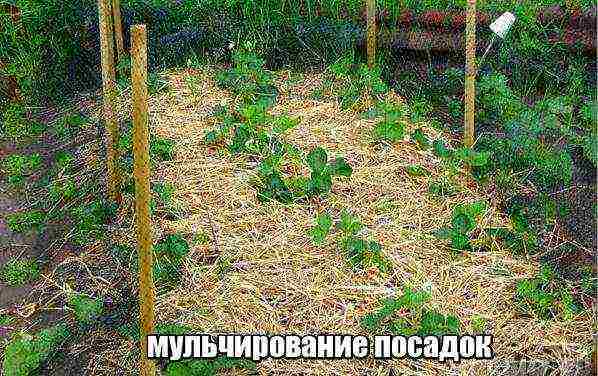
Additional mulching with pine or spruce needles will also be useful, which will serve as an obstacle for pests, protect against diseases, and keep the berries clean.
Choose the most suitable planting method and method for you, use the techniques of experienced gardeners - and a rich harvest of tasty and fragrant berries will always decorate your table.
Rate the quality of the article. We want to be better for you:
